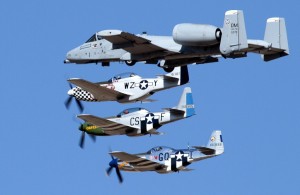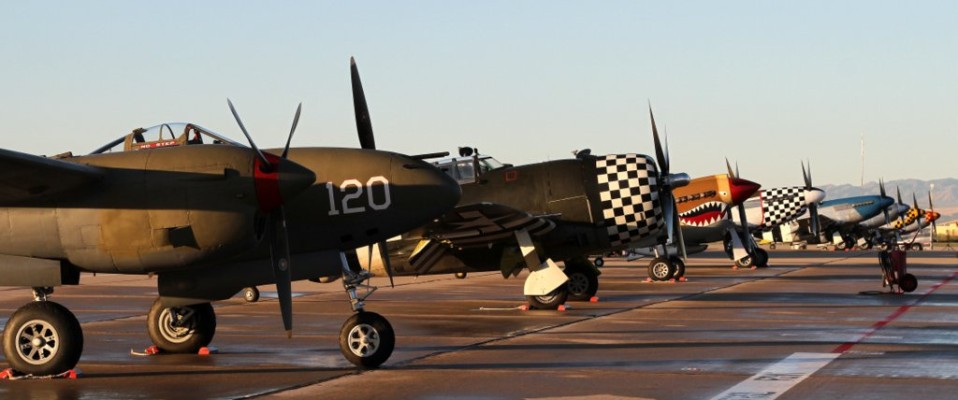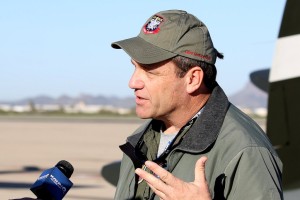2015 Heritage Flight Training and Certification Course: US Air Power History in the Desert
Article by Barry Griffiths
Photos by Barry Griffiths & Bill Word, with a few contributions from Steven Valinski
March 21, 2015
In 1997, when the USAF Air Combat Command authorized the first Heritage Flight as a one-time event, it was intended to celebrate the 50th anniversary of the USAF. This dramatic display of USAF Air Power included fighter/attack aircraft from the conflicts in WW II, Korea and Vietnam flying solo routines and various flight formations before the public.
Now, eighteen years later, this living museum of USAF history continues to be a huge success as it celebrates the honour and sacrifice of those who served, past and present, in the USAF. In addition, it has been a prime educational tool in informing the general public of the long-term national importance of the US Air Force.
Since 2010, the Air Force Heritage Flight Foundation (AFHFF), a non-profit organization, has been dedicated to showcasing the nation’s air power history around the world with this very popular program. Now, every year, the warbirds and current USAF fighter aircraft gather together in the Tucson desert at Davis-Monthan AFB to train for the upcoming show season.
Past Heritage Flight Training
I was fortunate to be in Tucson during the bittersweet 2012 Heritage Flight Conference where exciting displays put on by the remarkable, but now retired, F-4 Phantoms and the (possibly) soon to be retired A-10C Thunderbolt IIs. Air Power history at its best!
The four-ship USAF F-4 Phantom II Demo Team, in its Vietnam War-era camouflage paint, trained along with a stunning array of vintage warbirds and current fighter/attack aircraft for that upcoming show season. The venerable F-4 Phantom, an exceptionally successful multi-role aircraft, introduced into the USAF in 1963 and retired in the late 1990’s, had been a very popular performer in many previous solo and Heritage Flights. Now, this was to be the last year for the USAF F-4 Phantom II Demo Team as it was to be disbanded at the end of the 2012 air show season.

Mustangs TF-51 “Bum Steer” P-51D “Galveston Gal” P-51D “Live Bait” in formation with A-10C 355th Wing King @ 2012 Heritage Flight Conference, Davis-Monthan AFB (KDMA), AZ
In addition, the A-10C “Warthog”, with its well-earned reputation as being the ugliest but toughest warplane in the USAF inventory, was in its twilight years as a Heritage Flight and solo performer. This close air support “flying tank”, flown exclusively by the USAF and the Air Reserve components, was scheduled to be taken out of service after 2015. Although its current deployment to the ISIS conflict in the Middle East has spared it for the time being, it’s unlikely that it will be featured in airshows again.
2015 Heritage Flight Training Program
When I arrived at Davis-Monthan AFB, shortly after day-break and under sunny blue Arizona skies, for the 2015 Heritage Flight Conference, I was met with three flight lines; one for the WW II warbirds, another for the Korean-era jets, and the last reserved for the state-of-the-art F-22 and F-16 fighters. These aircraft, including the incomparable P-48 Lightning, P-51 Mustang, P-47 Thunderbolt, P-40 Warhawk and F-86 Sabre, plus the F-16 Viper and F-22 Raptor from Air Combat Command, had been flown in from all over the US to participate in the 2015 Heritage Flight Training during which the pilots would qualify to perform Heritage Flights safely in air shows and events around the world.
During the next three days, the flying activities of this magnificent array of USAF Air Power were intense, as the civilian and military pilots practised their formation flights and solo performances. In discussing the 2015 Heritage Flight program with some of the pilots, I was impressed with their professionalism and keen dedication and found out first hand that there was a great deal more to their respective roles than initially met the eye.
When asked about their reactions to flying in the Heritage Flights, F-22 Raptor Demo Pilot Captain John Cummings replied that ”It’s fun to do all of the manoeuvers in the show, but when you get to do them with the warbirds, that’s the coolest part”. P-51 pilot Charles Hainline felt that “Since I am retired military, it’s just great to be around and with our young USAF airmen”.

Lockheed Martin/ Boeing F-22A Raptor 09-4187 94th FS “Hat in the Ring” 1st FW FF Langley AFB, VA (Captain John Cummings) @ Heritage Flight Conference, Davis-Monthan AFB, Tucson, AZ
Every pilot in the Heritage Flight formations is qualified as a lead pilot and, when designated, has the formidable task of orchestrating a smooth formation of vastly dissimilar aircraft safely through their routine. Since the aircraft in the flight have critically different flight characteristics, each pilot has to develop a comfort zone where they are aware of the potential and limitations of all aircraft. In other words, the lead pilot can’t slow everyone down to a more comfortable flight envelope knowing that two of the aircraft are on the edge; the P-40 Warhawk working as hard as it can just to keep up and the F-16 Viper working just as hard to go slow.
I discussed this issue with pilot Charles “Tuna” Hainline, a retired USAF Lieutenant Colonel and now a warbird pilot in the Heritage Flight. He expressed the point that “when you are flying in formation with dissimilar aircraft, every time you change a basic parameter, such as turning or changing altitude, each plane reacts a little bit differently. Therefore, the key to this type of formation flying is being very smooth, very precise and knowing how the other aircraft are performing relative to their capabilities”.
Charles “Tuna” Hainline also expressed the point that each aircraft has different angles of attack at low speeds and this characteristic affects the F-16 and F-22 the most. “They experience a lot of induced drag which they manage by changing the power settings; however, a movement of one eighth of an inch of throttle on an F-16 is equal to about one inch of throttle on a P-51, so even small changes can dramatically affect the smooth operation of the flight”. This was highlighted during a two-ship practice when observing the F-22 Raptor slushing along nose high besides the straight and level P-51 Mustang.

Lockheed Martin/ Boeing F-22A Raptor 09-4187 &; North American P-51K Mustang N98CF, Two ship @ Heritage Flight Conference, Davis-Monthan AFB, Tucson, AZ
F-22 Raptor pilot Captain John Cummings responded that “to do the Heritage Flight right is definitely a challenge” and “one of the major components of this Conference is to have a training sortie for each formation we fly and find out what the differences are in each aircraft’s flight profile”.
Although Davis-Monthan AFB was not open to the public for the 2015 Heritage Flight Training program, it sought to honor the contributions of men and women who have served in the USAF by inviting Air Force retirees and active duty service members to enjoy the Heritage Flight Training weekend. All of the assembled warbirds and current fighters entertained the spectators as they flew in dozens of different training configurations, ranging from breathtaking solo performances to the two-ship, three-ship and four-ship formations of every imaginable aircraft combination.
These Heritage Flights have now become a much anticipated USAF Air Power demonstration at most national and international air shows and over the years have touched millions of people and helped preserve the historical importance of these airborne warriors from the past and present.
During the upcoming 2015 air show season, and for the foreseeable future, spectators will continue to enjoy watching these rare formations of classical and current USAF aircraft in the Heritage Flights program.
A special thanks to Lt. Erin Ranaweera, SSgt Courtney Richardson, Nicole Dalrymple, and the remainder of the 355th FW Public Affairs team for their hospitality and assistance during the 2015 Heritage Flight Training and Certification Course.
Barry Griffiths is a published author, wildlife photographer and naturalist. After a successful career as an educator, he became founder and President of Quest Nature Tours, a company specializing in worldwide nature tours and expedition cruising. On his retirement from these endeavors, he continues to photograph wildlife and pursue his lifelong interest in all aspects of aviation.
Barry can be reached at: [email protected]


